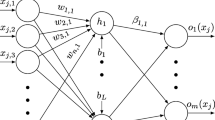Abstract
Online Value-at-Risk (VaR) analysis in high-dimensional space remains a challenge in the era of big data. In this paper, we propose an online sequential learning non-parametric VaR model called OS-GELM which is an autonomous cognitive system. This model uses a Generalized Autoregressive Conditional Heteroskedasticity (GARCH) process and an online sequential extreme learning machine (OS-ELM) to cognitively calculate VaR, which can be used for online risk analysis. The proposed model not only learns the data one-by-one or chunk-by-chunk but also calculates VaR in real time by extending OS-ELM from machine learning to the non-parametric GARCH process. The GARCH process is also extended to one-by-one and chunk-by-chunk mode. In OS-GELM, the parameters of hidden nodes are randomly selected. The output weights are analytically determined based on the sequentially arriving data. In addition, the generalization performance of the OS-GELM model attains a small training error and generates the smallest norm of weights. Experimentally obtained VaRs are compared with those given by GARCH-type models and conventional OS-ELM. The computational results demonstrate that the OS-GELM model obtains more accurate results and is better at forecasting the online VaR. OS-GELM model is an autonomous cognitive system to dynamically calculate Value-at-Risk, which can be used for online financial risk assessment about human being’s behavior. The OS-GELM model can calculate VaR in real time, which can be used as a tool for online risk management. OS-GELM can handle any bounded, non-constant, piecewise-continuous membership function to realize real-time VaR monitoring.


Similar content being viewed by others
References
Youssef M, Belkacem L, Mokni K. Value-at-risk estimation of energy commodities: a long-memory GARCH–EVT approach. Energy Econ. 2015;51:99–110.
Kim M, Lee S. Nonlinear expectile regression with application to value-at-risk and expected shortfall estimation. Comput Stat Data Anal. 2016;94:1–19.
Liang N-Y, Huang G-B, Saratchandran P, Sundararajan N. A fast and accurate online sequential learning algorithm for feedforward networks. Neural Netw IEEE Trans. 2006;17(6):1411–23.
Platt J. A resource-allocating network for function interpolation. Neural Comput. 1991;3(2):213–25.
Bildirici M, Ersin ÖÖ. Improving forecasts of garch family models with the artificial neural networks: an application to the daily returns in istanbul stock exchange. Expert Syst Appl. 2009;36(4):7355–62.
Ghorbel A, Trabelsi A. Energy portfolio risk management using time-varying extreme value copula methods. Econ Model. 2014;38:470–85.
Berman JJ, Principles of big data: preparing, sharing, and analyzing complex information, Newnes, 2013.
Li G, Liu M, Dong M. A new online learning algorithm for structure adjustable extreme learning machine. Comput Math Appl. 2010;60(3):377–89.
Grossberg S. Nonlinear neural networks: principles, mechanisms, and architectures. Neural Netw. 1988;1(1):17–61.
LeCun YA, Bottou L, Orr GB, Müller K-R, Efficient backprop, in: Neural Networks: Tricks of the Trade, Springer, 2012:9–48.
Huang G-B, Saratchandran P, Sundararajan N. An efficient sequential learning algorithm for growing and pruning RBF (GAP-RBF) networks. Syst Man Cybern Part B: Cybern IEEE Trans. 2004;34(6):2284–92.
Zou H, Jiang H, Lu X, Xie L, An online sequential extreme learning machine approach to WiFi based indoor positioning, in: Internet of Things (WF-IoT), 2014 I.E. World Forum on, IEEE, 2014:111–116.
Huang G-B, Zhu Q-Y, Siew C-K. Extreme learning machine: theoryand applications. Neurocomputing. 2006;70(1):489–501.
Golub GH, Van Loan CF, Matrix computations, 3rd (2012).
Huang G-B, Zhou H, Ding X, Zhang R. Extreme learning machine for regression and multiclass classification. Syst Man Cybern Part B: Cybern IEEE Trans. 2012;42(2):513–29.
Tamura S, Tateishi M. Capabilities of a four-layered feedforward neuralnetwork: four layers versus three. Neural Netw IEEE Trans. 1997;8(2):251–5.
Chong EK, Zak SH, An introduction to optimization, Vol. 76, John Wiley & Sons, 2013.
Giot P, Laurent S. Modelling daily value-at-risk using realized volatility and arch type models. J Empir Financ. 2004;11(3):379–98.
Kupiec P. Techniques for verifiying the accuracy of risk management models. J Deriv. 1995;3:73–84.
Engle RF, Manganelli S. CAViaR: conditional autoregressive value at risk by regression quantiles. J Bus Econ Stat. 2004;22(4):367–81.
Engle RF, Autoregressive conditional heteroscedasticity with estimates of the variance of united kingdom inflation, Econometrica: Journal of the Econometric Society 1982: 987–1007.
He K, Lai KK, Yen J. Ensemble forecasting of value at risk via multi resolution analysis based methodology in metals markets. Expert Syst Appl. 2012;39(4):4258–67.
Vong C-M, et al. Imbalanced learning for air pollution by meta-cognitive online sequential extreme learning machine. Cogn Comput. 2015;7(3):381–91.
Savitha R, Suresh S, Kim HJ. A meta-cognitive learning algorithm for an extreme learning machine classifier. Cogn Comput. 2014;6(2):253–63.
Cao K, et al. Classification of uncertain data streams based on extreme learning machine. Cogn Comput. 2015;7(1):150–60.
Funding
This research is supported by China Postdoctoral Science Foundation funded project, the National Social Science Foundation (15BJY155) and the National High Technology Research and Development Program of China (863 Program) (2015AA050203).
Author information
Authors and Affiliations
Corresponding author
Ethics declarations
Ethical Approval
All procedures performed in studies involving human participants were in accordance with the ethical standards of the institutional and/or national research committee and with the 1964 Helsinki declaration and its later amendments or comparable ethical standards.
Rights and permissions
About this article
Cite this article
Zhang, HG., Wu, L., Song, Y. et al. An Online Sequential Learning Non-parametric Value-at-Risk Model for High-Dimensional Time Series. Cogn Comput 10, 187–200 (2018). https://doi.org/10.1007/s12559-017-9516-y
Received:
Accepted:
Published:
Issue Date:
DOI: https://doi.org/10.1007/s12559-017-9516-y




